NOTE: I consider myself an aggregator, meaning I dig into topics that interest me, find information that is helpful and interesting, pull resources together and then present everything to you while sprinkling in my own colorful commentary. My goal is to pique your interest enough that you will want to read more, learn more and maybe adopt some new thoughts/attitudes/habits that will help you on your journey.
Did you know that over 50% of the dogs in the US are classified as either overweight or obese? Wow. After discovering this I totally understand why I was compelled to write an article about the Fat Dog Epidemic in the US. As I started doing some research, however, I found quite a few very well researched and well written articles about the dangers of our overweight pet population (see Resources).
“So Lisa, why are you writing yet another article about the overweight dog epidemic?”
Thank you for asking because in my very humble opinion, it’s quite obvious that no one is reading them. They are not even looking at the pretty pictures that show the stages between too thin and very obese. And if they did look at the pretty pictures, they decided that those guidelines did not apply to them. So, using the Law of Averages theory, this article, which is a compilation of my observations as well as other websites/blogs/articles, just might find someone who is not aware and will open their eyes. Maybe.
So, let’s dive in, shall we?
Obesity is the most common preventable disease in dogs.
“My dog is fine. I am feeding the amount shown on the bag of kibble that we use.”
Just so you know, it is NEVER advisable to follow those feeding guidelines. Never. The “guidelines” are always for too much kibble. Always.
Think you can trust your Veterinarian to let you know if your pet is overweight? Not necessarily. Sadly most vets either avoid this conversation or tell the human that their overweight dogs are perfectly normal.
One reason veterinarians fail to discuss weight issues with pet owners is because they believe they may upset the owner. 84% of veterinary professionals responded that a pet owner had “appeared embarrassed or angry after being told their pet was overweight or needed to lose weight.” 1
And then there is this interesting study about implicit bias in Veterinarians:
Participants took something called the Implicit Association Test, or IAT. This test measures automatic thoughts we’re not even aware we have. Over 90% of veterinary professionals showed some unconscious preference for lean people over those who were overweight. If doctors and staff aren’t aware of these mental shortcuts (and shortfalls), they can interfere with how they treat clients and how seriously they address obesity in pets.
– Dr Ernie ward
Bias isn’t just a feeling. It shapes how we behave. Here’s where implicit weight bias gets real for veterinary professionals:
• A client with an overweight dog might feel blamed and judged, even if it’s not said out loud.
• Vets may avoid talking about obesity with certain clients, especially if they assume those clients won’t follow through.
• Vets might overlook a pet’s obesity altogether because they are uncomfortable starting the conversation due to the person’s/family’s body condition.
Pet obesity prevention.org
Twenty or so years ago, I was on the receiving end of the “your dog is too fat” conversation. Being told that my dog was overweight was taken as a personal critique of me more so than my dog. During an agility workshop, when I was working with my first agility dog, I was told Sophie should skip a few meals. It did not sit well. In fact, I was kinda insulted.
Looking back, that agility instructor was absolutely correct, but I was too proud and vain and indignant to see it. However, I am glad that she said something because I did get Sophie’s weight in check. It didn’t happen right away, but it did happen.
“Owner denial is one unfortunate reality of U.S. dogs and their weight problems. Association for Pet Obesity and Prevention’s surveys have shown that 95% of owners of overweight dogs don’t realize their dogs suffer from the ailment.”3
And now there are so many pet people who have dogs in obedience classes, beginning agility classes and competing in agility trials (don’t even get me started on the confirmation ring) and their dogs are quite visibly overweight and uncomfortable.
No matter who or what is in my beginner agility class, I make a point to talk about body conditioning. Sadly, for the ones who really need to hear it, my body conditioning chat usually goes in one ear and out the other or is met as an affront to their “parenting” skills. Too bad, actually, because their dogs deserve better.

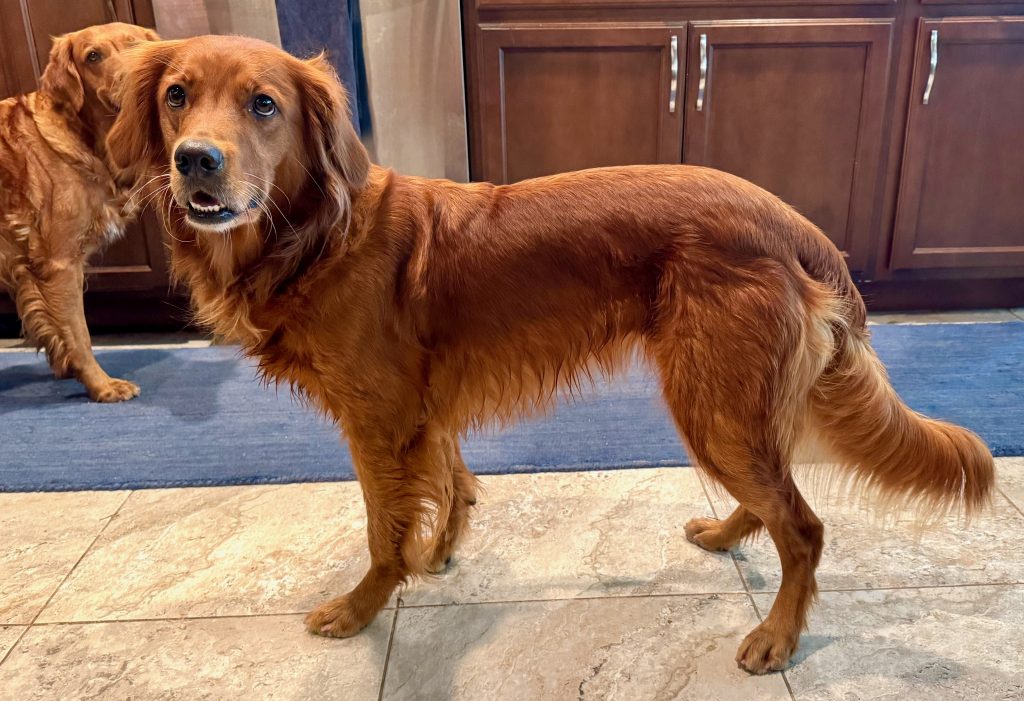
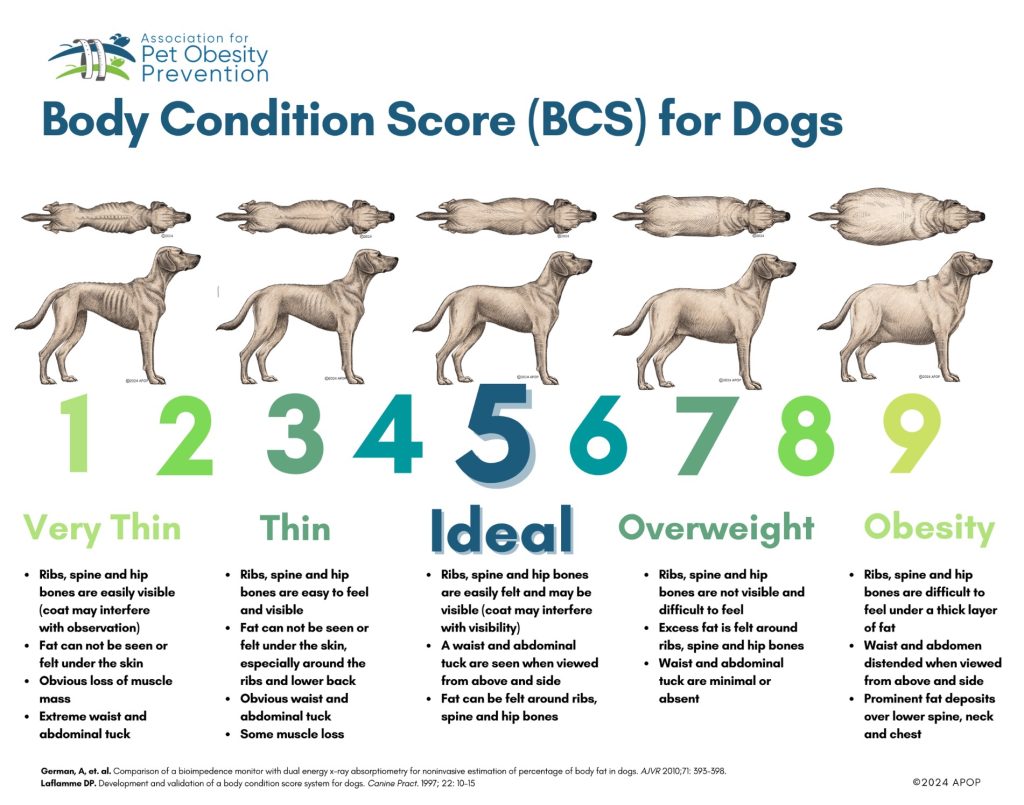
The first graph, provided by Purina, has been around for a few decades. It has been “graphically modernized” by other sources but the information has not changed. The second graph is provided by the Association for Pet Obesity Prevention and is a little fancier, but has the same information. Both graphs are very helpful in analyzing your dog’s condition. If you need to, take a photo of your dog from the top and then from the side while they are in a stand and then find a similar condition on either graph. Have a breed with a large, heavy coat? Go for a swim, grab an outdoor hose or hit your indoor shower and get your hands on your wet dog. And then? Be honest with yourself about your dog’s condition.
Not sure how to “feel” for ribs and hip bones? Check out this video from the “Our Pets Health” YouTube channel.4
“Ok, Ok, Lisa. Maybe, just maybe, our sweet Muffin is a teenie weenie bit overweight. So what? She’s fine. Why should we care?”
“I see people coming in constantly with 90-pound Labs and they say, ‘she looks great,’” says Dr. Ernie Ward, DVM, CVFT, and founder of the Association for Pet Obesity Prevention (APOP). “Well, actually, that dog is 15 pounds overweight. But we’ve normalized it.” This kind of dog embodies what APOP has called the “fat pet gap”—the misalignment between what we think a dog should look like and what a healthy body composition should really be. Obesity in dogs comes with significant consequences. In fact, Ward and other vets call it our pets’ biggest health threat. And it’s not an isolated issue; obesity is linked to a whole raft of health problems including arthritis, chronic kidney disease, bladder/urinary tract disease, liver disease, low thyroid hormone production, diabetes, heart failure, high blood pressure, and cancer. “We think it’s very important that people understand this isn’t just a cosmetic issue,” says Dr. Ward. “There is a physiological consequence to this.”5
Need it spelled out? Here is an extensive list of health concerns found on the Darwins Pet blog:3
Obese dogs have a higher risk of having:
- Breathing problems and respiratory disease
- Many types of cancer
- Heart disease
- Hypertension
- Osteoarthritis and faster degeneration of joints
- Urinary problems and urinary bladder stones
- Metabolic disorders, including diabetes
- Anesthetic complications during surgery
- Chronic inflammation
- Increased risk for anesthetic complications during surgery
- Slower recovery after surgery
- Tearing the anterior cruciate ligament (or ACL) in one of the dog’s hind legs
- Fat causes increases in inflammatory hormones and creates other stresses on body tissue, both of which contribute to disease
- Increased risk for osteoarthritis and faster degeneration of affected joints
- Skin allergies and conditions
- Increased risk of orthopedic problems
- Increased risk of liver disease
- Lowered immune system function
- Increased risk of non-cancerous tumors
- Increased risk of pancreatitis
- Lower quality of life
- Shortened life span
“Ok, Lisa. Maybe, just maybe, our sweet Muffin might be between 7 and 9 on the BCS graph. So what now? We can’t just STARVE her so what can we do? We love her soooooo much!”
It’s time veterinary healthcare professionals begin treating obesity first. The status quo has been to treat symptoms first, often masking the underlying disease and only addressing other issues if they cause additional problems. Another complicating factor is that treating obesity has historically taken significant time, and failure to adhere to strict diets or exercise regimens can derail even the best intentions and outcomes. Finally, discussing obesity with patients and clients can be challenging due to the stigma and bias associated with the term. 6
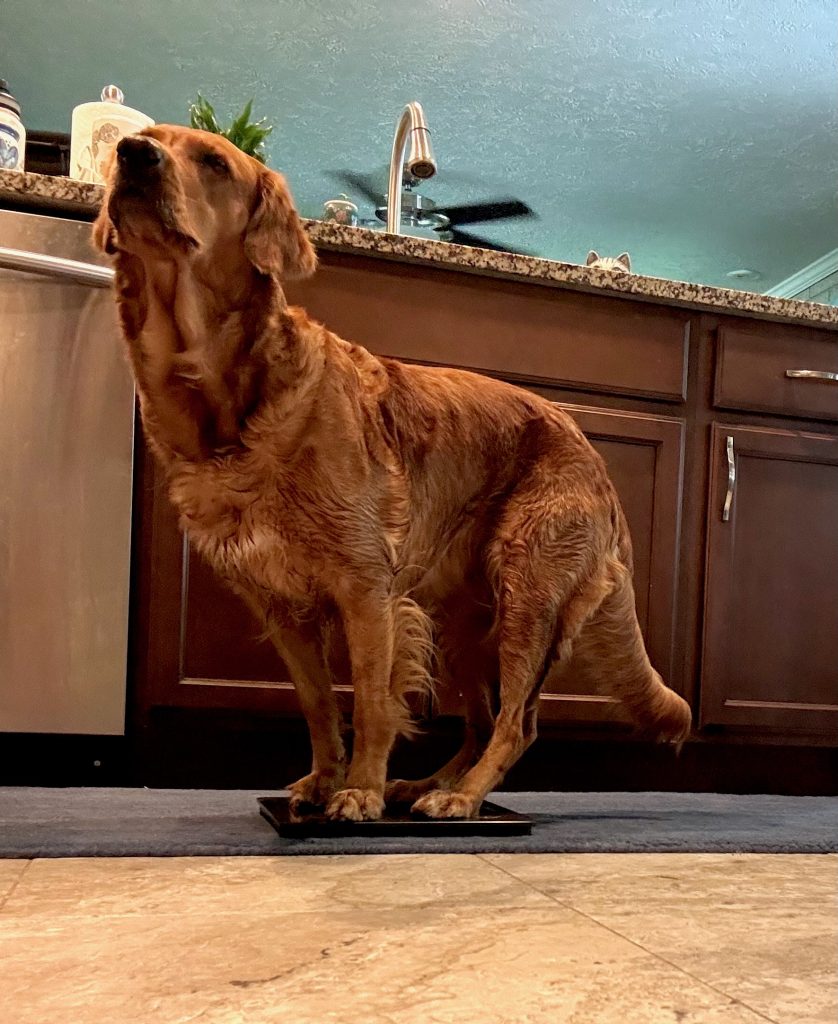
Weigh your dog once a week or at the very least once a month. I have taught my dogs to get all 4 on our scale. It’s a trick. Or you could #1 weigh yourself #2 pick up and hold your dog and weigh both of you #3 subtract number #1 from #2 and that will tell you how much your dog weighs. I use the calendar app on my iPad and the notes section to keep track of each dog’s weekly weigh-in.
If you would like to get an idea of what a “live” healthy dog should look like, check out a sport dog. Mine do dog agility and I work them and feed them like the athletes they are. On the BCS, they would be considered Thin – probably between 3-4. If one of them starts sliding into a 5, the “ideal” shape, I would cut back on the amount of food and treats I give for a week or two and reweigh and reassess. It is a constant work in progress. If you find that your dog kinda looks like a 7 or 8, you can do the same: cut back a little every day. Weigh again in a week or two and continue adjusting from there.
For a dog to maintain a healthy weight, the standard suggestion is a minimum of 20 minutes of exercise each day. This can include a neighborhood walk, a game of fetch in the yard, playing frisbee, going for a hike, swimming, or spending time running around a local dog park. However, the amount and type of exercise are contingent on your dog’s age and overall health. If you work outside the home and your dog is alone for several hours each day, consider hiring a dog walker to visit daily to ensure your dog is receiving adequate exercise, then take them on another walk once you’re home from work.9
For the past 30 or so years, I have been walking a dog (almost) every single morning. I believe so much in our daily walks that I wrote an article about it last year and it’s available on my blog here.8
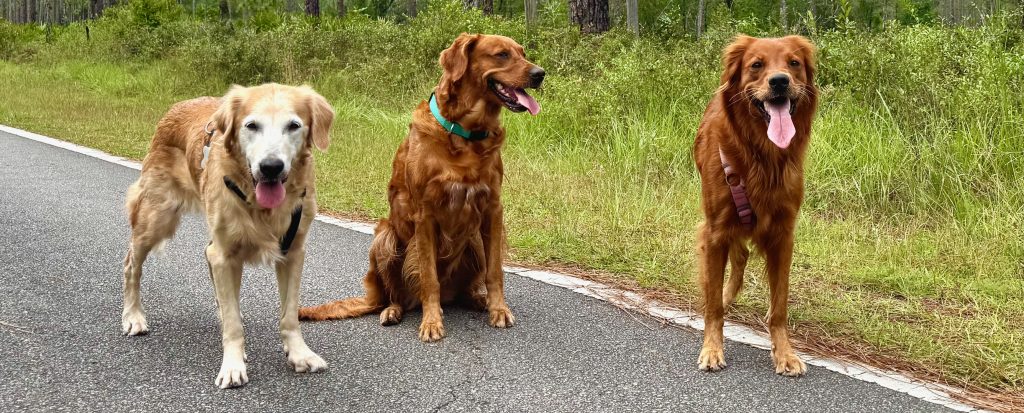
Today, my dogs and I are out for at least an hour every morning and then we have a 20 minute walk in the evening. I’ve also been keeping a list of all the additional activities that we do before we go for the evening walk. We play fun games or learn tricks or play fetch or work on certain agility or trick skills or maybe go swimming. I try to do something different every afternoon. Usually our sessions are pretty high intensity but short – so they get a couple sessions each and for all three dogs, we’re done in less than 20 minutes.
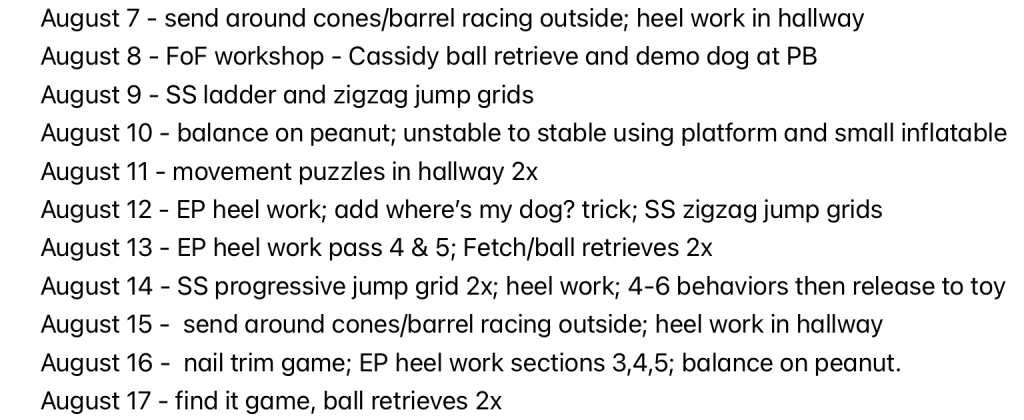
Monitoring your dog’s routine activities can provide insights into their health. Create a simple activity log to track changes. Observing patterns in your dog’s energy levels will help you identify issues early. Making dietary adjustments combined with regular, moderate exercise can improve their condition. Remember, consistency is key to helping your dog regain a healthy lifestyle.7
“But Lisa,” you say, “what normal person has time for that?”
It’s understandable that most pet people have jobs and families and other things that may make it difficult to spend the extra time working with, training and exercising their dogs. Instead of trying to fit in an hour+ chunk for walks and training each day, maybe three 15-20 minute walking/training sessions would fit better. Or maybe it’s six 10-minute sessions of walking or a quick game of retrieving or a find-it game or off leash time to sniff and run at will. Whatever time you can carve out will reward you and your dog in ways you might never have considered.
Quick note: not all dog food is created equal. High quality proteins and fats are the best way to keep your dog fit and healthy. Most kibble is full of not so great grains and other carbohydrates that do nothing but create fat dogs.10 In addition, we should be feeding our carnivores what nature intended … meat/bones/organs. Check out the Orijen White Paper.11 The link to the PDF is in Resources.

Remember, when it comes to our pets, food doesn’t equal love. Time spent doing something with your dog is much more rewarding than just dumping extra kibble in his bowl or tossing some extra cookies his way because you feel guilty for missing yet another daily walk. Want to reward your dog with a tasty treat? Take the time and work on some fun tricks together – nice, short sessions a few times a day are perfect. Can you squeeze in 2-3 minute training sessions perhaps 2-3 times throughout your day? I promise that both of you will enjoy your special time together and your dog will get to use his brain AND his brawn AND will get to earn those tasty treats in the process. Win. Win. Win.
Our dogs deserve every moment of our time and every consideration for their health and well-being. The bottom line is to provide the best food, care, training and fun for your dog so that he can live his best life. I believe it’s a very small price to pay for all that we get in return.
Resources
If you are interested in learning more, and I hope you are, here are links to the great resources I used/pulled from with lots more pretty pictures and graphics to help you on your journey:
2. What’s Weighing Us Down: Study Uncovers Implicit Bias in Veterinary Obesity Care
3. Complete Guide to Canine Obesity
4. The Simple Way To Know If Your Dog Is Overweight – Veterinarian Explains
5. Obesity in Dogs: A Major Health Threat Hiding in Plain Sight
6. The Importance of Treating Obesity First
7. How To Tell If Your Dog Is Overweight And What To Do About It
8. Benefits of daily walks with your dog(s)
9. What Your Veterinarian Needs You To Know About Your Dog’s Weight
10. 6 foods your dog should avoid to lose weight
11. Orijen White Paper – Very informative. Written over 20 years ago, but dogs haven’t changed … they are still carnivores and should be fed as such.

Leave a Reply